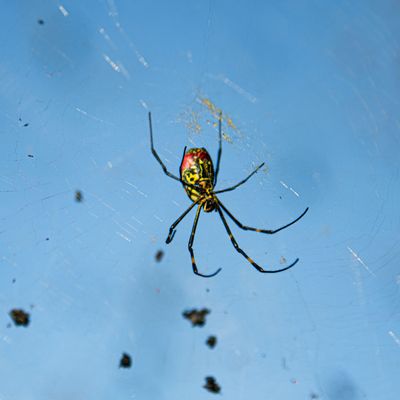
Which would you rather: be plagued by clusters of polka-dot insects or have Post-It-size spiders parachute into your city? Next year, New Yorkers may have the distinct misfortune of dealing with both, because a species of enormous invasive spiders known to eat lanternflies is expected to arrive in our city. Start spreading the news!
A recent scientific paper predicted that joro spiders are primed for a major move to the Big Apple. Experts are so sure that the huge spiders are coming that one ecologist deemed it “a matter of when, not if.” The joro species, known formally as trichonephila clavata, is native to East Asia but has been in the U.S. since at least 2014, when one was seen in northern Georgia. Since then, the eight-legged critters have been spotted in South Carolina, North Carolina, Alabama, Tennessee, and Maryland, and evidence suggests they are rapidly spreading north. Apparently, New York is on the same latitudinal line as the location where the spiders are most common in Asia; that means our city is the perfect distance from the equator for the joros to thrive. Clemson University professor David Coyle, who co-authored the new study, observed in the New York Times that joros also are unusually comfortable in urban environments. He’s seen them on streetlamps and telephone poles in Georgia, which are apparently places “regular spiders wouldn’t be caught dead in.” In other words, they won’t mind paying $3,000 a month for a studio apartment with no A/C.
Joros are an invasive species, not to mention horrifying to behold. The New York Times described their appearance as “hair-raising,” and their size has been compared to both a human palm and a Post-It note. The average adult female joro (they’re bigger than males) measures six to eight inches, which includes their three-inch leg span and a thumb-size abdomen filled with eggs. They have bright designs on their bodies and legs that are largely yellow and black, giving them the skin-crawling vibe of a bumble bee–spider hybrid.
They’ve also been known to parachute through the air, thanks to a little strand of silk they can shoot out to catch the wind. But if you, like me, are imagining a cloud of enormous spiders descending from the New York sky like an army of spindly paratroopers, you can rest easy. According to Coyle, joros can’t travel as far as New York on their little balloons, since the closest they seem to have come so far is Maryland. But he says they’re “really good” at attaching themselves to vehicles, like those coming into the city for a little holiday jaunt. Once here, they can absolutely airlift themselves several miles — between boroughs, say, or from the Cloisters to Bad Roman to your local park. Coyle told CBS News that only the small joro spiders do the whole parachuting thing, so “people don’t even know that there are tiny spiders in the sky.” Does he think that is reassuring?!?!?
On the one hand, the joros would be a formidable ally in our ongoing crusade against spotted lanternflies. On the other hand, all spiders eat other bugs, so they are not that special. But even if they don’t help us with the lanternflies, they’re not known to mess too much with food ecosystems. Also, they’re not very aggressive, and scientists have assured the public that their venom is too weak to hurt anyone; getting bit would feel like a bee sting at most. One researcher told the Times that “if you leave it alone, it will leave you alone.” Just another New York freak to ignore.






